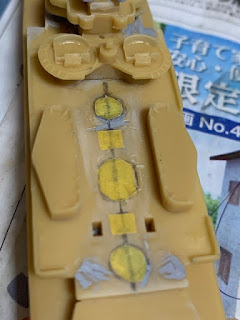...I need to do something about the whole pile of model kits I've acquired from a couple of years of trolling online shops and auction sites. In the last half of 2019 a lot of purchases had the characteristic of being "Oh, heck...why not?" type of acquisitions. Sometimes the decisions left me wondering what in the world I was thinking of when I clicked on the "buy" or "bid" buttons. One of them was the 1/700 scale model kit of HMS Suffolk which was produced by a company called B-Resina.
First of all, why did I bid on the kit? Probably because it represents Suffolk which was a County class cruiser that sported a cut down quarterdeck. This modification was done to only two members of the class of ships. I have collected all four of the County class cruiser kits released by Aoshima over the past year and half or so, not to mention a re-scaled version of HMS Dorsetshire...oh, and a pre-war version of HMS Dorsetshire. Okay, that's five kits in that stash.
The B-Resina kit of HMS Suffolk has been around for some time. I'm not sure for how long. A review of the kit written at the time of its release surmises that it's a scaled down version of Airfix's 1/600 scale model of the ship. Interestingly enough, the B-Resina kit is pretty well a perfect copy of the bigger model, and it copies the idiosyncrasies of the big brother. If you want to know what those are then I recommend digging up a review which I came across on Steelnavy.com....I think.
So, having purchased the kit, and looking at the stash of RN County class cruisers I had built up, I decided to start building it right away. That doesn't mean it'll be built in a hurry but at least it'll end up spending some time on my work table as an in progress project.
First step in the project was to chop off the hunks of resin plastic which didn't belong. That involved cutting out the solid mass under the lower bridge wings. Then I decided I didn't like the look of the bridge tower. So off came the deck at its base. Next, I went out and bought some chisel style "Exacto" knife blades and removed the funnels. They are too close together and leaning too far back according to kit review. I tried to removed the gun crew and ammo shelters next. That didn't happen as they are securely molded onto the deck. My attempt to remove one resulted in a piece of the deck flying off. I did manage to find it and reattach it.


Having cut off a lot of the ship, I then went about adding parts back on. I didn't like the shape or location of the forward section of the bridge. But it's solidly molded onto the ship and rebuilding it would take more effort than I wanted to put in given the nature of the project. So I settled with adding a piece of plastic card on top of it. The deck at the base of the bridge tower was shaped from plastic card and the original kit bulwark, albeit a bit shorter thanks to the razor saw cut made to remove it, was reattached.


The net result wasn't pretty but it was good enough...for the time being. Having completed those steps, I prepped the kit for a coat of primer. But first I marked off on the deck where the funnels were going to go. Taking this step means I don't have to scrape primer off the ship when attaching the funnels. The original kit didn't have what I suspect were two ventilator housings between the funnels. I scrounged up parts for them from some other kits. The locations of the housings and the funnels were taken from a 1/700 scale kit of HMS Kent.
The height of the bulwark around the deck at the base of bridge tower started to annoy me. So I went about cutting strips of thin plastic card, shaping them, and then attaching them. The net result looked a lot rougher than desired even after puttying and sanding. A second run at that process came up with the result shown below. Not great but when I held the ship at arms length, not too noticeable. I may take a third run at it yet.
Having done that, I attached the masts and then gave the kit a coat of primer:
At this point in time I've started painting the ship's camouflage. In the past, when dealing with camouflage patterns that involve wavy or curvy shapes, I've resorted to hand painting. With a pattern that has straight lined blocks then masking is employed. For this project I went about making a do-it-yourself masking sheet. I found a drawing of the ship online, scaled up the drawing to 1/700 scale, printed it on a sheet of paper, put the printed paper image into a clear folder, and applied masking tape over top. The Tamiya brand masking tape is thin enough such that I could make out the pattern underneath. After drawing the shape onto the tape and removing the unwanted parts with a knife, I had myself a primitive masking sheet for the hull of the ship.
Of course, the hilarious part of this is that there isn't much contrast between the first two colours applied to the model. Hopefully it will be more noticeable when looked at under natural lighting instead of fluorescent lighting.





















